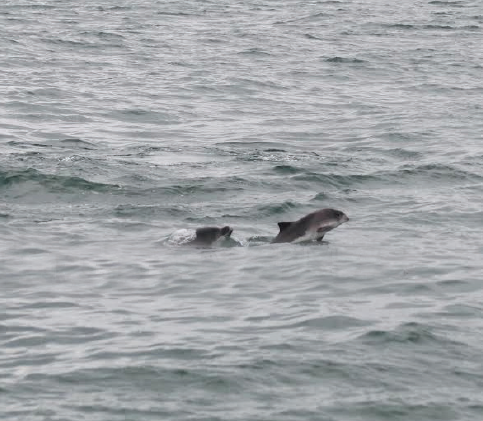 SEVEN DOLPHINS participated in ‘porpicide’ in Cardigan Bay this weekend when they aggressively attacked a young harbour porpoise.
SEVEN DOLPHINS participated in ‘porpicide’ in Cardigan Bay this weekend when they aggressively attacked a young harbour porpoise.
The dolphins involved have now been photographed and are under observation due to their behaviour.
Cardigan Bay Marine Wildlife Centre’s Marine Team participated in a four hour dolphin survey this weekend as part of The Wildlife Trust’s Dolphin Survey Boat Trips.
However, part way through their survey they witnessed seven Bottlenose dolphins acting aggressively towards a young harbour porpoise. The marine team were amazed to witness the dolphins acting aggressively in that manner and proceeded to observe and document the event.
Sarah Perry, Wildlife Trust Living Seas Science Officer, said: “For decades we have known that Bottlenose dolphins attack harbour porpoises, an act known as ‘porpicide’, a behaviour that has been documented around the world. However, the reasons for these attacks remains poorly understood. Various theories have been proposed including prey competition, objectorientated play, practising infanticide and heightened aggression in male Bottlenose dolphins. Interestingly, this isn’t the first time we have observed this behaviour in the Cardigan Bay Bottlenose dolphins. In 2014, we observed this behaviour first-hand on four separate occasions”.
Cardigan Bay Marine Team photographed the dolphins involved prior to the latest encounter and are now continuing to document and observe their behaviour. At least two of the dolphins involved were males, two were females and there were also two young dolphins in the group – including one dolphin that had faint foetal folds visible, which suggests it was less than a year old.
Sarah Perry continued to say: “Although slightly distressing, observing aggressive behaviour such as this is fascinating to both members of the public and researchers alike. Most days I am left in awe of the dolphin’s power and stealth and hunting abilities. Their behaviours and social systems are complex and encounters with these animals never fail to amaze me. There is no doubt that the Bottlenose dolphins of Cardigan Bay are an inspiration to everyone that is lucky enough to catch a glimpse of them as they go about their daily lives, myself included.”
Encounters such as this demonstrate that we still have a lot to learn about these enigmatic creatures, showing that it is vitally important that we all make an effort to conserve our seas and the marine environment we live in for future generations to enjoy, be inspired and learn from such events.
For further information on vital research work carried out by The Wildlife Trust of South and West Wales or Cardigan Bay Marine Wildlife Centre, please visit www. welshwildlife.org or www.cbmwc. org.















Add Comment